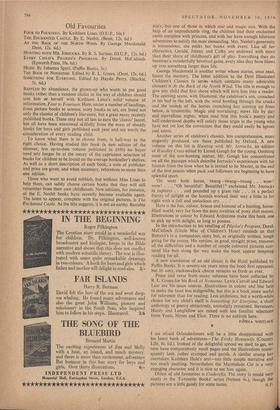Old Favourites
FOUR TO FOURTEEN. By Kathleen Lines. (O.U.P., 16s.) THE ENCHANTED CASTLE. By E. Nesbit. (Benn, 12s. 6d.) HEIDI. By Johanna Spyri. (Puffin Books, 3s.)
BAFFLED by abundance, the grown-up who wants to put good books rather than a random choice in the way of children should arm him or herself with Kathleen Lines's solid volume of information, Four to Fourteen. Here, under a number of headings, from picture books to science, story books to art, are listed not only the classics of children's literature, but a great many recently published books. These may not all last to earn the 'classic' laurel, but all have been winnowed skilfully from the mass of shoddy books for boys and girls published each year and are worth the consideration of every reading child.
To know what there is to choose from, is half-way to the right choice. Having studied this book (a new edition of the slimmer, less up-to-date volume published in 1950) no buyer need any longer be at the mercy of the capricious selection of books for children to be found on the average bookseller's shelves. As well as a short description of each book, a note of publisher and price are given, and when necessary, references to more than one edition.
Those who want to avoid rubbish, but without Miss Lines to help them, can safely choose certain books that they will still remember from their own childhoods. New editions, for instance, of the E. Nesbit books have recently become available again. The latest to appear, complete with the original pictures, is The Enchanted Castle. As the title suggests, it is not an earthy Bastable ******* 1k*** ***** *************
story, but one of those in which real and magic mix. With the help of an unpredictable ring, the children find their enchanted castle complete with princess, and with her have enough hilarious adventures to satisfy the most demanding. Mrs. Nesbit's generosity is tremendous; she packs her books with Client. Like all her characters, Gerald, Jimmy and Cathy are endowed with more than their 'share of childhood's gift of play. Everything they do becomes a wonderfully involved game, every idea they have blows up into something larger than life.
George Macdonald is another writer whose stories, once read, haunt the memory. The latest addition to the Dent Illustrated Children's Classics (a series which contains many admirable choices) is At the Back of the North Wind. The title is enough to give any child that first shove which will turn him into a reader. The opening scene, with Diamond, the cabdriver's son, crouched in his bed in the loft, with the wind howling through the cracks and the sounds of the horses crunching hay coming up from below, is irresistible. Magic and moralising; mews life by day and marvellous nights; when read first this book's poetry and half-understood depths will satisfy those urges in the young who have not yet lost the conviction that they could easily be heroes and saints.
Another series of children's classics, less comprehensive, more elegantly produced, are those published by Oxford. A new volume on this list is Hunting with Mr. Jorrocks, an edition of Handley Cross edited by Lionel Gough for the young. Omitting most of the non-hunting matter, Mr. Gough has concentrated on all the passages which describe Jorrocks's experiences with his hounds from the time when he is invited to be Master, to the end of the first season when pack and followers are beginning to have splendid sport.
'On went both horns, twang—twang--twang . . . wow! wow! . . . "Oh beautiful! Beautiful!" exclaimed Mr. Jorrocks in raptures . . . and pounded up a grass ride . . . in a perfect frenzy of delight as the hounds worked their way a little to his right with a full and melodious cry. . .
Here is the fun, colour, breeze and humour of a hunting, horse- filled world, very far from the testy rivalries of pony club stories. Illustrations in colour by Edward Ardizzone make this book one to pick up with delight, to long to possess.
In the introduction to his retelling of Pilgrim's Progress, Derek McCulloch (Uncle Mac of Children's Hour) reminds us that Bunyan's is a tremendous story but, as originally written, tough going for the young. His version, in good, straight prose, removes all the difficulties and a number of simple coloured pictures scat- tered like bait along the way make the book appear tempting reading for all.
A new translation of an old classic is the Heidi published by Puffin Books. It is seventy-six years since the book first appeared, but its cosy, cuckoo-clock charm remains as fresh as ever.
Prose and verse from many volumes have been collected by R. L. Green for his Book of Nonsense. Lewis Carroll and Edward Lear are his main sources. Illustrations in colour and line help to make the feast less indigestible, but this is a book more useful for reference than for reading. Less ambitious, but a worth-while choice for any child's shelf is Something for Everyone, a short anthology of poetry attractively, unstodgily presented. Stevenson, Hardy and Longfellow are mixed with less familiar selections from Yeats, Noyes and Eliot. There is no rubbish here.
PAS4ELA WHITLOCK
AM afraid Orlando-lovers will be a little disappointed with his latest book of adventures—The Frisky Housewife (Country' Life, 8s. 6d.). Instead of the delightful spread we used to get, we now have comparatively small pages and the illustrations conse- quently look rather cramped and garish. A similar cramp has overtaken Kathleen Hale's text—too little simple narrative and too much padding. Nevertheless the Marmalade Cat is a very engaging character and it is nice to see him again.
Oldest of old favourites is Cinderella. The story is retold very nicely in the 'Favourite Books' series (Nelson 4s.), though the
pictures are a little gaudy for some tastes. H. F.


















































 Previous page
Previous page